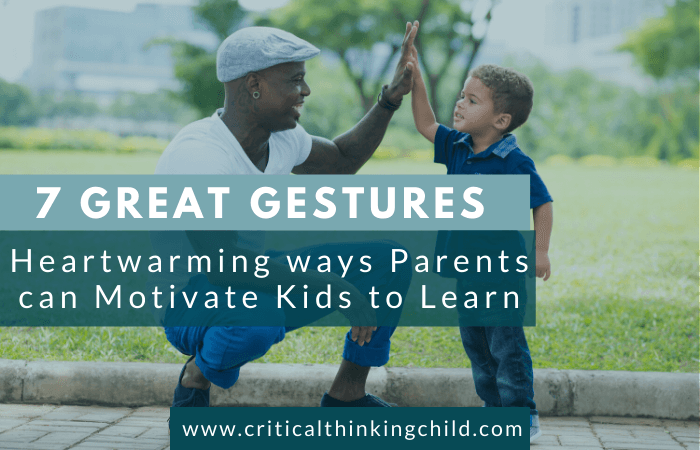Motivating your child can sometimes feel like a moving target. What works one day may not work the next, which can be incredibly frustrating as a busy parent! While some children are naturally motivated, the vast majority need a little help, especially when they are struggling or hitting an academic plateau.
The good news? Sometimes something as simple and quick as a gesture of approval or acceptance can change the game. Here, we’ll help you take charge of motivating your child with small gestures that can make a big difference.
Why does motivation matter?
For years, scientists believed the most important factor in student success was innate ability and intelligence — not motivation. When journalist Paul Tough researched the science behind student success for his book How Children Succeed: Grit, Curiosity, and the Hidden Power of Character, he found something surprising.
As it turns out, base intelligence is a small piece of a much larger picture. It’s now clearer than ever that character traits like persistence, self-confidence, and optimism are far more important than natural ability.
With this in mind, the challenge for busy parents becomes fostering those character traits in a way that will lead to success for your child.
Intrinsic vs. Extrinsic motivation
There are two main types of motivation: intrinsic and extrinsic. Intrinsically motivated children do things because they like them and they find them personally rewarding and fulfilling. On the other hand, children who are extrinsically motivated take on tasks so they can get a prize or avoid punishment.
This is a broad generalization, of course — all children are intrinsically motivated towards some things, and extrinsically motivated towards others. Like so many things (learning styles, for example), motivation exists on a spectrum. That said, many students lean towards being intrinsically (or extrinsically) motivated more often.
Ultimately, the more intrinsically motivated children will typically find greater success since they find the rewards for their behavior inside themselves rather than from an outside force. As a parent, you can help motivate your children and foster intrinsic motivation. This will help them build confidence in themselves and find fulfillment within. And it all starts with a few simple gestures.
7 simple, heartwarming gestures to help motivate your child
Praise is a simple way to encourage motivation in your child, and gestures are a non-verbal way of showing praise, affection, and attention.
Seemingly small gestures can have a huge impact on your child’s motivation and self-confidence.
Here are a few that are easy to incorporate into your day-to-day support of your child.
The Fist Bump
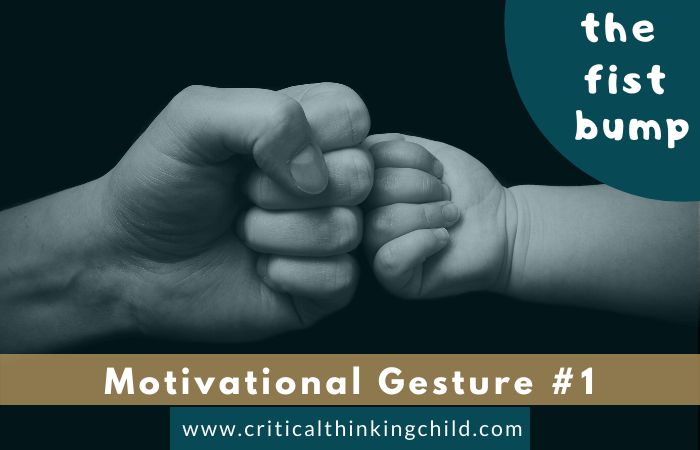
The fist bump is a great form of greeting for parents looking to have a “cool” relationship with their children. You can even follow the fist bump with a special handshake to strengthen the unique bond between you and your child.
This is a great way to greet your child after school each day or when you haven’t seen them in a few hours. An added bonus is that it spreads fewer germs than the high five or handshake since your fists are closed.
The High-Five
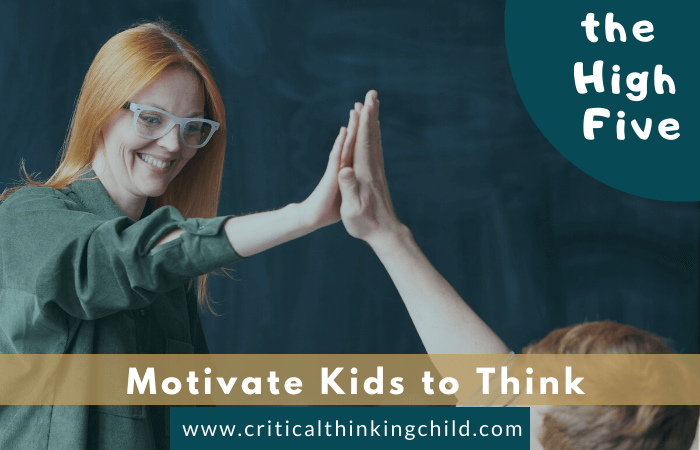
A high-five can be a greeting, but more often it is used as a praise gesture. If you’re working on homework and your child perseveres through a challenging problem, a quick high-five would be a great gesture of respect and celebration. Be careful when using high-fives to not only celebrate the “correct” answer but rather celebrate effort, perseverance, and curiosity.
Waving Hello or Goodbye

Every child needs to feel important, and enthusiastically waving goodbye or hello to your child is an easy way to reinforce their importance in your life. This sets their day off to a good start if you wave goodbye when you drop them off at school, and waving hello sets a positive tone for the rest of your evening together as a family.
Hugging (Bear Hugs Included!)
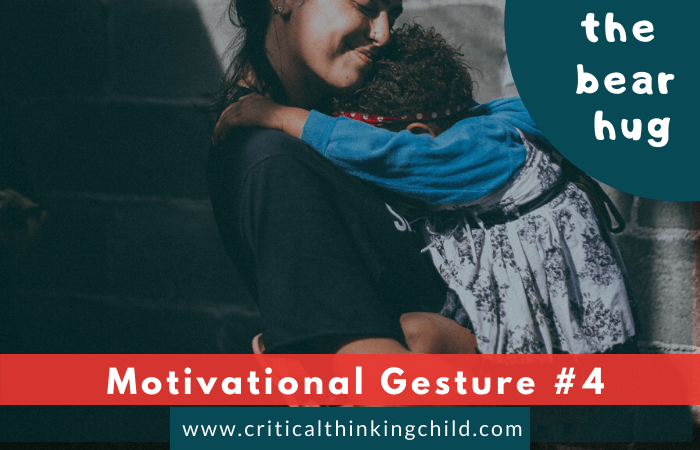
It may seem counterintuitive, but one of the best times to hug your child is when they’re at their worst. You may be worried about sending mixed messages, but hugging your children when they are acting out shows them that you still value them and love them unconditionally. Additionally, lots of brain research shows that hugging reduces stress hormones in the body and helps people bond, so hug away!
Celebration Dance
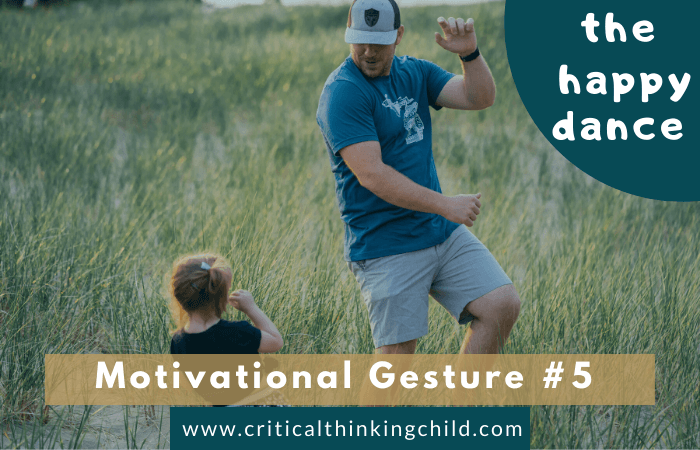
Lifting your arms in celebration is a small gesture that carries a lot of weight, so use this one sparingly. In many different cultures, this triumphant gesture is a sign of victory or celebration. You can save this gesture for when your child completes big events, like finally performing in a piano recital they were worried about or trying out for the school play.
Again, you can use this gesture to praise the outcome (making the cut) or the process (trying something new and scary), but it’s usually better to praise the process of working through challenging new things.
Thumbs up or Nod of Approval

A small nod (or thumbs up) can go a long way, especially with children who struggle with performance anxiety. Often, they’ll look for outward signs that they’re on the right path, and a simple gesture of this type can provide that reassurance. It’s a silent way of showing encouragement and camaraderie, while also indicating that you’re giving your child your full attention.
Put your hands together
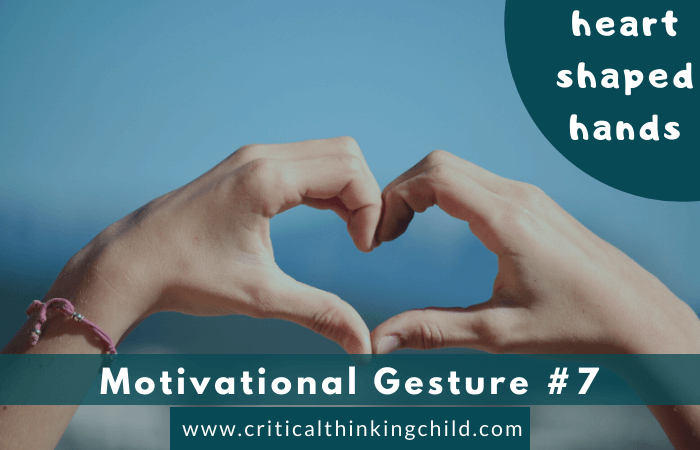
Like many of the above gestures, applause (or heart-shaped hands) indicates a celebration or moment of appreciation. It’s a non-verbal way of saying “good job” or expressing adoration that can help instil confidence in your child. Applauding can be an effective way to congratulate your child when they put forth a strong effort — regardless of the outcome. If you find applause disruptive you can use the heart-shaped hand gestures but make sure your child can see it.
Supportive gestures support motivation
Remember, praising your child for effort goes much farther than external rewards and prizes. It’s so important to celebrate those incremental successes, strong attempts, and genuine moments of creativity and joy. Not only does it help your child stay motivated, but these gestures help you build a loving bond with your child, allowing them to feel appreciated.
Keep our gestures in mind to see your child’s motivation soar!
Read Next: Heartwarming Children’s Book about Love.
Sources used:
https://www.parents.com/kids/development/behavioral/6-ways-to-motivate-your-kids/

